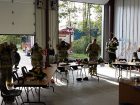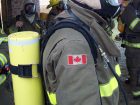
Back to Basics: January 2017
By Mark van der Feyst
Features TrainingA basic tenet of firefighter survival is the foundational knowledge and training that supports everything we do – in other words, the basics or the foundations of fire fighting. These basics help firefighters with self-rescue, should it ever be required.
There are five key areas that every firefighter needs to know to be adequately prepared for self-rescue. We’ll look at the first three here.
Know your equipment
Equipment can help a trapped or lost firefighter find his or her way to safety.
- Personal protective equipment (PPE) includes everything firefighters wear on their bodies: pants, coats, hoods, helmets, SCBA, boots, and gloves. PPE protect us, and protect us well; it is designed to work in a failing environment. It is important for firefighters to know and understand PPE – how it works, how to put it on properly and quickly, whether it works properly, and how to troubleshoot problems.
- It’s also crucial that firefighters know their trucks, and the gear carried on them. Knowing what equipment is on the trucks, how it works, how to properly use it, and where it is located on the truck makes firefighters more efficient and effective. Do you know which tools to grab when you arrive at a certain type of incident?
- Portable radios are perhaps the most essential piece of equipment to have in order to self-rescue and survive. The portable radio is the lifeline between firefighters and the incident commander or additional help. Knowing how to use the radio is crucial: Which special buttons are on your portable radio to help you in a distress situation? Are you comfortable speaking on the radio? And do you know how to speak into the radio? Firefighters should refrain from yelling into the microphone or holding the mic directly in front of their mouths; rather speak with the mic off to the side in order to send a clear message.
Know your crew
There is an inter-personal aspect of self-rescue and survivability that involves skill level and attitudes.
- During self-rescue, it is important to be aware of the skill levels of other firefighters. Are the firefighters in your crew or on scene new to the service and have only basic firefighting knowledge? Have the firefighters been around for a while but have little extra training and, therefore, have only basic knowledge and skills? Or are the skill levels high? Firefighters who have poor or basic skills will be ineffective in an emergency situation. Firefighters who have strong skills will be in a better position to help themselves or crew members during emergency situations.
- Attitude goes hand in hand with skill levels. There are firefighters who have excellent attitudes toward their jobs or services, who want to learn as much as they can, and who want to do their jobs in the best manner possible. These firefighters generally have high skill levels and positive outlooks and attitudes. Firefighters who have poor attitudes are generally not interested in training or bettering themselves; their skill levels may parallel their attitudes – very low and very basic.
- Firefighters need to identify which colleagues have great attitudes and high skill levels, and which have poor attitudes and low skill levels. This is important because when firefighters encounter an emergency situation, they must know whether they can depend on their partners or colleagues for help or if they are, essentially, on their own.
Know your response area
This area looks pre-planning and the benefits of knowing the response area. Knowing the response areas gives firefighters the tools they need to better understand what they’re dealing with when a fire call comes in. How does pre-planning help with firefighter survivability? When firefighters know building layouts, building types and building construction methods, and are aware of buildings that are under construction or renovation, they can better manage the incident and their own safety.
Sometimes, for firefighters, our workplace is inside a building, and the building has no respect for the job that we must do. When a building is stressed with fire and heat conditions, it will succumb to the effects of these factors regardless of whether we are inside. Having a unique knowledge of a building’s history and structure will help firefighters to escape it when it decides to fail.
When can pre-planning take place? All the time! Any time firefighters get a call for any type of response – medical, carbon monoxide, smoke alarm going off, service, lift assists – the opportunity is available to pre-plan buildings, and not just commercial, public-access or industrial buildings, but residential structures too.
There are buildings in every response are that firefighters need to be aware of – buildings that present unique hazards based on configuration, occupancy, or fire load inside the building.
Regardless of the reason, knowing the building may be the key to firefighter survival. This can be accomplished only by getting out into the repose area and visiting buildings – doing walk throughs and tours of the buildings, and getting to know the buildings inside and out.
Knowing the equipment and knowing the crew helps firefighters be prepared when faced with a life-or-death situation and must self-rescue.
In April, we will look at the remaining two foundational skills that firefighters need to posses to perform self-rescue.
Mark van der Feyst has been in the fire service since 1999. Mark instructs in Canada, the United States and India. He is the lead author of the book Residential Fire Rescue. Mark@FireStarTraining.com
Print this page

